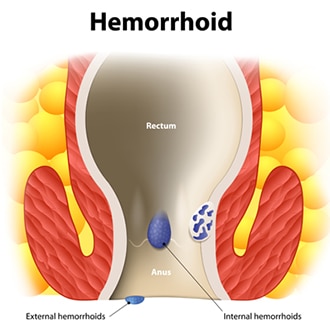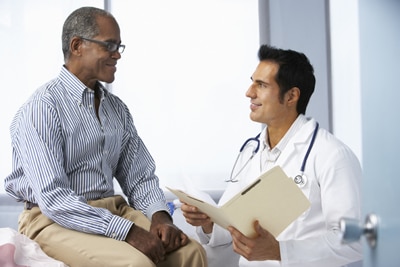Hemorrhoids
Return to Overview PageDefinition & Facts
In this section:
- What are hemorrhoids?
- How common are hemorrhoids?
- Who is more likely to get hemorrhoids?
- What are the complications of hemorrhoids?
What are hemorrhoids?
Hemorrhoids, also called piles, are swollen and inflamed veins around your anus or in your lower rectum.
The two types of hemorrhoids are
- external hemorrhoids, which form under the skin around the anus
- internal hemorrhoids, which form in the lining of the anus and lower rectum

How common are hemorrhoids?
Hemorrhoids are common in both men and women1 and affect about 1 in 20 Americans.2 About half of adults older than age 50 have hemorrhoids.2
Who is more likely to get hemorrhoids?
You are more likely to get hemorrhoids if you
- strain during bowel movements
- sit on the toilet for long periods of time
- have chronic constipation or diarrhea
- eat foods that are low in fiber
- are older than age 50
- are pregnant
- often lift heavy objects
What are the complications of hemorrhoids?
Complications of hemorrhoids can include the following:
- blood clots in an external hemorrhoid
- skin tags—extra skin left behind when a blood clot in an external hemorrhoid dissolves
- infection of a sore on an external hemorrhoid
- strangulated hemorrhoid—when the muscles around your anus cut off the blood supply to an internal hemorrhoid that has fallen through your anal opening
- anemia
References
Symptoms & Causes
What are the symptoms of hemorrhoids?
The symptoms of hemorrhoids depend on the type you have.
If you have external hemorrhoids, you may have
- anal itching
- one or more hard, tender lumps near your anus
- anal ache or pain, especially when sitting
Too much straining, rubbing, or cleaning around your anus may make your symptoms worse. For many people, the symptoms of external hemorrhoids go away within a few days.
If you have internal hemorrhoids, you may have
- bleeding from your rectum––bright red blood on stool, on toilet paper, or in the toilet bowl after a bowel movement
- a hemorrhoid that has fallen through your anal opening, called prolapse
Internal hemorrhoids that are not prolapsed most often are not painful. Prolapsed internal hemorrhoids may cause pain and discomfort.
Although hemorrhoids are the most common cause of anal symptoms, not every anal symptom is caused by a hemorrhoid. Some hemorrhoid symptoms are similar to those of other digestive tract problems. For example, bleeding from your rectum may be a sign of bowel diseases such as Crohn’s disease, ulcerative colitis, or cancer of the colon or rectum.
When should I seek a doctor’s help?
You should seek a doctor’s help if you
- still have symptoms after 1 week of at-home treatment
- have bleeding from your rectum
What causes hemorrhoids?
The causes of hemorrhoids include
- straining during bowel movements
- sitting on the toilet for long periods of time
- chronic constipation or diarrhea
- a low-fiber diet
- weakening of the supporting tissues in your anus and rectum that happens with aging
- pregnancy
- often lifting heavy objects
Diagnosis
How are hemorrhoids diagnosed?
Your doctor can often diagnose hemorrhoids based on your medical history and a physical exam. He or she can diagnose external hemorrhoids by checking the area around your anus. To diagnose internal hemorrhoids, your doctor will perform a digital rectal exam and may perform procedures to look inside your anus and rectum.
Medical history
Your doctor will ask you to provide your medical history and describe your symptoms. He or she will ask you about your eating habits, toilet habits, enema and laxative use, and current medical conditions.

Physical exam
Your doctor will check the area around your anus for
- lumps or swelling
- internal hemorrhoids that have fallen through your anal opening, called prolapse
- external hemorrhoids with a blood clot in a vein
- leakage of stool or mucus
- skin irritation
- skin tags––extra skin that is left behind when a blood clot in an external hemorrhoid dissolves
- anal fissures—a small tear in the anus that may cause itching, pain, or bleeding
Your doctor will perform a digital rectal exam to
- check the tone of the muscles in your anus
- check for tenderness, blood, internal hemorrhoids, and lumps or masses
Procedures
Your doctor may use the following procedures to diagnose internal hemorrhoids:
- Anoscopy. For an anoscopy, your doctor uses an anoscope to view the lining of your anus and lower rectum. Your doctor will carefully examine the tissues lining your anus and lower rectum to look for signs of lower digestive tract problems and bowel disease. Your doctor performs an anoscopy during an office visit or at an outpatient center. Most patients do not need anesthesia.
- Rigid proctosigmoidoscopy. Rigid proctosigmoidoscopy is similar to anoscopy, except that your doctor uses an instrument called a proctoscope to view the lining of your rectum and lower colon. Your doctor will carefully examine the tissues lining your rectum and lower colon to look for signs of lower digestive tract problems and bowel disease. Your doctor performs this procedure during an office visit or at an outpatient center or a hospital. Most patients do not need anesthesia.
Your doctor may diagnose internal hemorrhoids while performing procedures for other digestive tract problems or during routine examination of your rectum and colon. These procedures include colonoscopy and flexible sigmoidoscopy.
Treatment
How can I treat my hemorrhoids?
You can most often treat your hemorrhoids at home by
- eating foods that are high in fiber
- taking a stool softener or a fiber supplement such as psyllium (Metamucil) or methylcellulose (Citrucel)
- drinking water or other nonalcoholic liquids each day as recommended by your health care professional
- not straining during bowel movements
- not sitting on the toilet for long periods of time
- taking over-the-counter pain relievers such as acetaminophen, ibuprofen, naproxen, or aspirin
- sitting in a tub of warm water, called a sitz bath, several times a day to help relieve pain
Applying over-the-counter hemorrhoid creams or ointments or using suppositories—a medicine you insert into your rectum—may relieve mild pain, swelling, and itching of external hemorrhoids. Most often, doctors recommend using over-the-counter products for 1 week. You should follow up with your doctor if the products
- do not relieve your symptoms after 1 week
- cause side effects such dry skin around your anus or a rash
Most prolapsed internal hemorrhoids go away without at-home treatment. However, severely prolapsed or bleeding internal hemorrhoids may need medical treatment.
How do doctors treat hemorrhoids?
Doctors treat hemorrhoids with procedures during an office visit or in an outpatient center or a hospital.
Office treatments include the following:
- Rubber band ligation. Rubber band ligation is a procedure that doctors use to treat bleeding or prolapsing internal hemorrhoids. A doctor places a special rubber band around the base of the hemorrhoid. The band cuts off the blood supply. The banded part of the hemorrhoid shrivels and falls off, most often within a week. Scar tissue forms in the remaining part of the hemorrhoid, often shrinking the hemorrhoid. Only a doctor should perform this procedure—you should never try this treatment yourself.
- Sclerotherapy. A doctor injects a solution into an internal hemorrhoid, which causes scar tissue to form. The scar tissue cuts off the blood supply, often shrinking the hemorrhoid.
- Infrared photocoagulation. A doctor uses a tool that directs infrared light at an internal hemorrhoid. Heat created by the infrared light causes scar tissue to form, which cuts off the blood supply, often shrinking the hemorrhoid.
- Electrocoagulation. A doctor uses a tool that sends an electric current into an internal hemorrhoid. The electric current causes scar tissue to form, which cuts off the blood supply, often shrinking the hemorrhoid.
Outpatient center or hospital treatments include the following:
- Hemorrhoidectomy. A doctor, most often a surgeon, may perform a hemorrhoidectomy to remove large external hemorrhoids and prolapsing internal hemorrhoids that do not respond to other treatments. Your doctor will give you anesthesia for this treatment.
- Hemorrhoid stapling. A doctor, most often a surgeon, may use a special stapling tool to remove internal hemorrhoid tissue and pull a prolapsing internal hemorrhoid back into the anus. Your doctor will give you anesthesia for this treatment.
Sometimes complications of hemorrhoids also require treatment.
How can I prevent hemorrhoids?
You can help prevent hemorrhoids by
- eating foods that are high in fiber
- drinking water or other nonalcoholic liquids each day as recommended by your health care professional
- not straining during bowel movements
- not sitting on the toilet for long periods of time
- avoiding regular heavy lifting
Eating, Diet, & Nutrition
What should I eat if I have hemorrhoids?
Your doctor may recommend that you eat more foods that are high in fiber. Eating foods that are high in fiber can make stools softer and easier to pass and can help treat and prevent hemorrhoids. Drinking water and other liquids, such as fruit juices and clear soups, can help the fiber in your diet work better. Ask your doctor about how much you should drink each day based on your health and activity level and where you live.
The Dietary Guidelines for Americans, 2020–2025 recommends a dietary fiber intake of 14 grams per 1,000 calories consumed. For example, for a 2,000-calorie diet, the fiber recommendation is 28 grams per day.
The amount of fiber in a food is listed on the food’s nutrition facts label. Some fiber-rich foods are listed in the table below.
| Fiber-rich Foods | |
|---|---|
| Food and Portion Size | Amount of Fiber |
| Grains | |
| 1/2 cup high-fiber bran, ready-to-eat cereal | 14.0 grams |
| 1 cup of shredded wheat, ready-to-eat cereal | 6.2 grams |
| Fruits | |
| 1 medium pear, with skin | 5.5 grams |
| 1 medium apple, with skin | 4.8 grams |
| 1 cup of raspberries | 8.0 grams |
| 1/4 cup of prunes | 3.1 grams |
| Vegetables | |
| 1 cup of green peas, cooked | 8.8 grams |
| 1 cup of collard greens, cooked | 4.8 grams |
| 1 cup of sweet potato, cooked | 6.3 grams |
| 1 medium potato, baked, with skin | 3.9 grams |
| 1 cup of winter squash, cooked | 5.7 grams |
| Beans | |
| 1/2 cup navy beans, cooked | 9.6 grams |
| 1/2 cup pinto beans, cooked | 7.7 grams |
| 1/2 cup kidney beans, cooked | 5.7 grams |
A doctor or dietitian can help you learn how to add more high-fiber foods to your diet.

What should I avoid eating if I have hemorrhoids?
If your hemorrhoids are caused by chronic constipation, try not to eat too many foods with little or no fiber, such as
- cheese
- chips
- fast food
- ice cream
- meat
- prepared foods, such as some frozen and snack foods
- processed foods, such as hot dogs and some microwavable dinners
Clinical Trials
The National Institute of Diabetes and Digestive and Kidney Diseases (NIDDK) and other components of the National Institutes of Health (NIH) conduct and support research into many diseases and conditions.
What are clinical trials and are they right for you?
Clinical trials are part of clinical research and at the heart of all medical advances. Clinical trials look at new ways to prevent, detect, or treat disease. Researchers also use clinical trials to look at other aspects of care, such as improving the quality of life for people with chronic illnesses. Find out if clinical trials are right for you.
Watch a video of NIDDK Director Dr. Griffin P. Rodgers explaining the importance of participating in clinical trials.
What clinical trials are open?
Clinical trials that are currently open and are recruiting can be viewed at ClinicalTrials.gov.
This content is provided as a service of the National Institute of Diabetes and Digestive and Kidney Diseases
(NIDDK), part of the National Institutes of Health. NIDDK translates and disseminates research findings to increase knowledge and understanding about health and disease among patients, health professionals, and the public. Content produced by NIDDK is carefully reviewed by NIDDK scientists and other experts.

